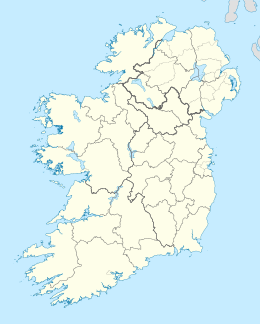Dursey Island
| Native name: Oileán Baoi | |
|---|---|

Dursey Island as seen from a hiking path on the mainland
|
|
| Geography | |
| Location | Beara Peninsula |
| Coordinates | 51°36′N 10°12′W / 51.600°N 10.200°WCoordinates: 51°36′N 10°12′W / 51.600°N 10.200°W |
| Area | 5.6 km2 (2.2 sq mi) |
| Length | 6.5 km (4.04 mi) |
| Width | 1.5 km (0.93 mi) |
| Highest elevation | 252 m (827 ft) |
| Administration | |
|
Ireland
|
|
| Province | Munster |
| County | Cork |
| Demographics | |
| Population | 3 (2011) |
| Additional information | |
| Official website | DurseyIsland.ie |
Dursey Island (Irish: Baoi Bhéarra or Oileán Baoi) lies at the southwestern tip of the Beara Peninsula in the west of County Cork in Ireland. Dursey Island is 6.5 kilometres long and 1.5 kilometres wide. The island is separated from the mainland by a narrow stretch of water, Dursey Sound, which has a very strong tidal race, with the submerged Flag Rock close to the centre of the channel. The island has just six or so permanent residents, and is connected to the mainland by Ireland's only cable car. Dursey has no shops, pubs or restaurants. At one point there was a post office on the island; this has now closed
The townlands on the island are Ballynacallagh, Kilmichael, and Tilickafinna. There are three main peaks, the highest 252m. The promontories and rocks off Dursey include:
Off the western point of the island are three rocks: Bull Rock, Cow Rock and Calf Rock. On Bull Rock in a tidal race stands a lighthouse built in 1888 and automated in March 1991. This island was inhabited until this time.
A manned lighthouse on Calf Rock was destroyed in a storm in 1881 and its remains can still be seen.
Cow Rock is home to a number of nesting colonies of seabirds. Dolphins, whales and basking shark are sometimes seen in the sea off the island.
Prehistoric sites have been surveyed on the island, including examples of bullaun and cup-marked stones in Ballynacallagh, a prehistoric hut site at Killowen, and a radial stone enclosure at Maughanaclea.
More prominent archaeological sites are visible at Ballynacallagh, where there is a ruined monastic church and graveyard, and at the site of a castle on Oileán Beag ("Small Island"). In 1602 this castle site was a garrison of the O'Sullivan Beare family. It was destroyed (along with Dunboy Castle) during the Nine Years' War. Philip O'Sullivan Beare documents that all of the occupants of the castle were killed by the English in the Dursey Massacre. The 300 islanders were killed; Donal Cam O'Sullivan Beare gathered his people from across Cork and set off to take shelter with the O'Rourkes of Leitrim. Of the 1,000 that set off, 35 survived to reach the O'Rourkes after the convoy was repeatedly attacked. Little evidence of the castle site remains.
...
Wikipedia

